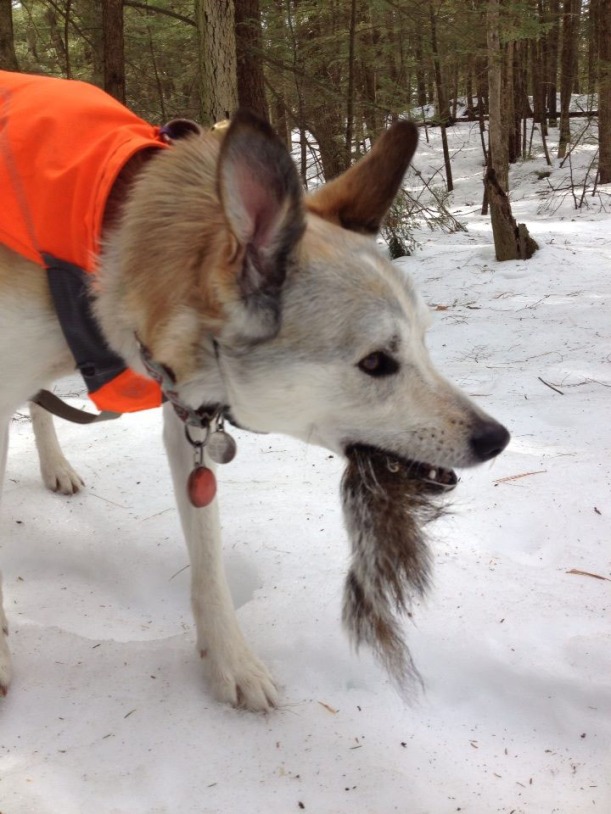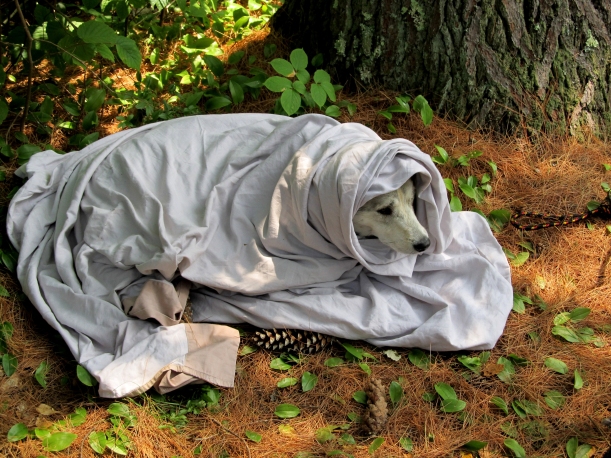A couple days ago the weather had me thinking really, really hard about what a day on the trail might be like when it ends by climbing into a tent. Granted it was the smell which hit me first as I opened my car door and my drenched pup looked at me, pleading to stay in the car where she wouldn’t have to get her toes wet again, she can be such a little princess when it comes to her toes. I wasn’t concerned whether or not she had enjoyed our hike in the rain, her running, frolicking and puppy grin had already answered any concerns I had. Instead it got me thinking of what it would be like to have an overnight and how would I deal with wet dog. 
What special accommodations do you need?
Depending on the trip this could be anything from sleeping accommodations to boarding or shuttle services. Lets start small and work our way up.
You’re headed out on the trail for a couple nights and want to be sure your dog is going to be comfortable. Everyone will have their own preference for how they set their pup up for bunking down. Some believe dogs, like wolves, are designed to sleep outside on the ground. Dogs aren’t wolves. Unless you have raised your dog outdoors and they understand how to settle in where they will stay warm, dry, and safe please provide them with what they need. That doesn’t mean bring the bed. But do provide them with a space where they will be safe and comfortable.
As I look at hiking the AT there are considerations I have to make, not for my dog but for the other hikers. During my research I discovered that dogs sleeping in shelters is not looked kindly upon. Yes, you can ask if people mind having a dog in the shelter but remember you are putting them in a position where they may feel pressured to be polite, especially if no one else minds. Instead pack accordingly. Plan to have either shelter for you and your dog or something for your dog. My personal preference is to share a tent with my pup. I may regret this after we hit the first big rain storm. My dog has the wettest wet dog smell ever!!! After just 15 minutes in a car everything stank of wet mutt. Now imagine climbing into a tent after a long day in the rain. You stink, they stink, your tent stinks!
Dog friendly accommodations
Some hostels along the AT allow dogs, just as some hotels do. But you can’t rely on this being the case. You need to be ready to bunk down with your pup if necessary. Dogs are allowed on almost all of the AT, but there are three sections of the trail where you cannot take them. The Great Smoky Mountain National Park through Tennessee and North Carolina is about a seven day hike. During which time you’ll need to have accommodations set up for your dog. Whether you know someone in the area who can take your dog for the week or you reach out to one of the shuttle and boarding kennels in the area. Current cost runs between $240-$300 for shuttle and kennel stay. I have contacted Standing Bear Farm via email and spoke briefly with Curtis, what an amazing resource he is. If you are planning a trip along the AT with or without a dog I would recommend checking out the hostel and the people.
Standing Bear Farm Hiker Hostel: http://www.standingbearfarm.com
Loving Care Kennels: http://www.lovingcarekennels.net
If you are leaving your dog with a kennel get in touch with them and find out what paperwork you need to have with you.
Bear Mountain State Park Trailside Museum and Wildlife Center in New York is another place where you can’t hike with you pup. This is a small section and there is an option to hike around via a road walk on U.S. 9W.
The third and final place where you are unable to take a dog is Baxter State Park in Maine. This means if you are hiking North Bound (NOBO) that you cannot peak out on Katahdin with your dog. For me this is the most heart breaking. If Star and I have truly made it all the way from GA to ME there is nothing more I would like to do then to take my final steps on the trail with her. Who knows maybe in a year they will allow AT dogs to hike the final steps. The hike through Baxter takes 2-3 days. Options are to kennel your dog or have a friend or family member meet you before you enter the park and take the dog. Many of the hotels in the area allow dogs for a small fee.
Yup keeping a dog happy on the trail isn’t all simple solutions of give them some food and call it a day. Planning is in order.
And since we are having such fun talking about sharing space with your pup let’s get into the truly friendly stuff. Dogs like to collect things. Maybe it’s a dead animal they just couldn’t resist rolling in, the ticks they gathered just for you, or maybe the giardia from the untreated water. Let’s take a moment and think about these things.
What are the environmental hazards?
Dogs are susceptible to many of the same illnesses and diseases that humans are. Dogs are able to contract diseases through ticks, mosquitoes, animals, and water. Dogs are also effected by the weather.
Tick borne illnesses
Some of the known tick borne diseases are, Lyme, Anaplasmosis, Hepatozoonosis, Babesiosis, and Ehrlichiosis. These diseases are transferred from either deer ticks or dog ticks. Lyme is the one most often heard about but all of these are present and can cause harm to your dog and some may be passable to you. Reduce the risk of ticks by treating your dog and yourself with repellant and doing frequent tick checks. Carry a flea comb with you as a way to check for creepy crawlies.
Insect borne illness
Next most aggravating and pesky issue is the mosquito. Not only are mosquitoes extremely annoying due to their itchy bite and extensive buzzing! But more important than how they annoy us is how they can be dangerous. Mosquitoes can infect a dog with heartworms. Being ahead of the mosquitoes is the way to go here. Doing preventative treatment is much less costly than treating after the fact. Heartworms like to breed and grow in the heart and lungs and can cut off blood supply to your dogs brain. Symptoms show up as the worms take up more space in the heart and lungs making it difficult to breath or circulate blood. Treatment is very costly and the dog must be kept calm while the worms die and clear out of their system.
Other critter dangers
Next up on the food chain are the animals which your dog might interact with. These may be anything from snakes to bears. Remember dogs are instinctual animals, the idea of investigating an exciting smell will probably outrank anything you can offer them. Star lives by her curiosity and this has definitely lead to some interesting situations. Snakes are fascinating to her, they slide along the ground vanishing into holes or under logs, they leave a fabulous scent trail and are totally unpredictable. Star loves hunting them! For me, in NH, this doesn’t raise any red flags as there aren’t poisonous snakes in the area. But once we hit the AT the curiosity could kill her. Rattle snakes, Cottonmouths, and Water Moccasins are all prevalent on the southern end of the AT. I have allowed Star to investigate snakes because I’d rather she see them than be so curious I can’t call her away from them. You should consider what would work best for your dog.
Knowing the terrain and what things are present will be important. If you store any gear outside your tent be sure to check it before putting it on or handling it. Again the Southern states provide us with delectable poisonous spiders. Not one but two! Black Widows and Brown Recluses are known to call it home in the mountains.
Now I don’t know if I should consider it a blessing or a curse that Star is curious but cautious. She wants to know about the other animals in the world but at her own pace, no racing into the path of danger, instead she just prods it. At any point she could run into a raccoon, skunk, or porcupine. Each of these animals are hazardous in their own way. All can carry rabies, skunks stink, and I personally don’t want to be on the trail with a skunked dog, and porcupines, well that’s just obvious. Quills although they may seem a small inconvenience while near a town could be extremely dangerous on the trail. A dog whose mouth is full of quills runs the risk of infection, dehydration, and other serious side effects. Getting them to a vet becomes a priority.
Anytime your dog is interacting with wild animals they are putting themselves and possibly you in danger. Dogs should not be chasing animals. A dog distracted by a small animal could get caught up and distracted by a new and more interesting smell. What started as chipmunk chase could end as a bear cub meet and greet or a wild run through the woods after a deer. These are opportunities for injury.
Will continue this post at a later time. Need to get away from fact finding and enjoy the present time!





